Agricultural Literacy Curriculum Matrix
Lesson Plan
Journey 2050 Lesson 2: Soil Nutrients (Grades 9-12)
Grade Level
Purpose
Students will identify nitrogen, potassium and phosphorus as primary soil nutrients necessary in the production of abundant and healthy foods, describe various methods of replenishing soil nutrients that have been depleted by plant growth, discover how overall plant health impacts a plant’s ability to resist disease and pests and describe what best management practices are in agriculture to improve overall sustainability. Grades 9-12
Estimated Time
Materials Needed
- 1 clear drinking glass with 8 equidistant marks (glass or plastic, use a grease pencil or dry-erase marker to add the marks)
- Water
- Drinking straw
- Journey 2050: Soil Nutrients video
- Soil Nutrients slide deck
- Sustainability Farming Game: Level 2 Nutrients
- Play online or download app
- Create Free Teacher Account to track student progress and print reports on Sustainability Farming Game.
- Computer or tablet device for each student
- Optional:
Vocabulary
4R Nutrient Stewardship System: helps farmers apply the right source of nutrients at the right rate, time and place on their fields
best management practices: methods that can improve efficiency, optimize resources, and prevent or help reduce pollution
fertilizer: any material of natural or synthetic origin that is applied to soils or plant tissues to supply one or more nutrients essential to plant growth
organic material: relating to living things; made without the use of artificial chemicals
Did You Know?
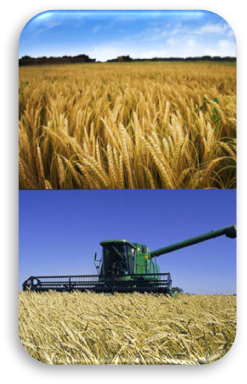 A bushel is the unit of measurement used when harvesting crops. It is about the size of a round laundry basket, and the weight varies by the crop.1
A bushel is the unit of measurement used when harvesting crops. It is about the size of a round laundry basket, and the weight varies by the crop.1- A modern combine can harvest 1,000 bushels of wheat per hour (1 bushel of wheat = 60 pounds).2
- The weight of a bushel varies by crop. A bushel of oats is 32 pounds, a bushel of corn is 70 pounds and a bushel of cotton is 32 pounds.3
- An acre is equal to 43,560 square feet, which is about the size of a football field not including the two end zones.4
- In areas where the soil is depleted of nutrients, applying fertilizer could double if not triple the crop yields.5
- Manufactured fertilizers are responsible for 50% of the world’s food supply.6
Background Agricultural Connections
Journey 2050 takes students on a virtual simulation that explores world food sustainability and answers the question, "How will we sustainably feed nearly 10 billion people by the year 2050?" The lesson plans and online simulation program allows students to make decisions on a virtual farm and witness their impact on society, the environment and the economy at a local and global scale. The lessons engage students with the important concepts regarding sustainable agriculture. The online simulation contextualizes these concepts as students experience the lives of three farm families in Kenya, India and Canada. As students interact with each family, they learn the role of best management practices in feeding the world, reducing environmental impacts, and improving social performance through greater access to education, medical care and community infrastructure. These lessons can be taught individually or as an entire unit. See the links below for the remaining lessons: ![]()
- Lesson 1: Sustainable Agriculture
- Lesson 2: Soil Nutrients
- Lesson 3: Water
- Lesson 4: Economies
- Lesson 5: Land Use
- Lesson 6: Careers
- Lesson 7: Technology and Innovations
- Take Action: Project-based Learning and Program Summary
Nutrients are essential. We need them to produce food. They provide energy and support the growth and maintenance of our bodies. Without adequate nutrients, people become malnourished and cannot protect themselves from disease.
We get our nutrients from plants and animals through the food we eat. Animals get their nutrients from the plants they eat, and plants take nutrients from the soil and elements from the air.
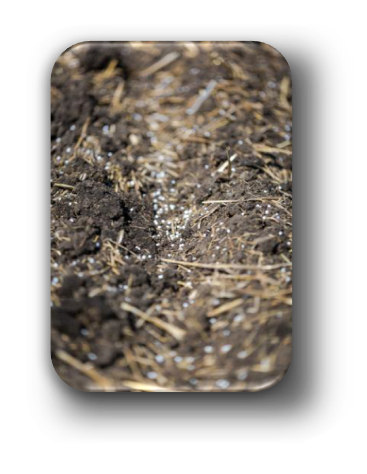 Plants require 17 essential nutrients. The primary nutrients are nitrogen (N), phosphorus (P) and potassium (K). Each nutrient does many things for the plant but the basics are these:
Plants require 17 essential nutrients. The primary nutrients are nitrogen (N), phosphorus (P) and potassium (K). Each nutrient does many things for the plant but the basics are these:
- Nitrogen is often called the Builder. It is necessary for chlorophyll synthesis, which helps the plant stay healthy, green and strong. Nitrogen helps make proteins as well.
- Phosphorus is referred to as the Enforcer. It helps the plant trap and use the sun’s energy to make food through photosynthesis. Plants also need phosphorus to grow healthy root systems.
- Potassium is the Protector. Potassium protects plants against diseases and helps them stay healthy when it is cold or dry by facilitating the movement of nutrients and water within the plant to where they’re needed most.
We may not realize it, but the soil beneath our feet is a vibrant source of life and nutrients. Soil is home to lots of living and non-living materials. This includes rocks, minerals, bacteria and countless insects and organisms so small you need a microscope to see them. It takes a long time to make soil. As rock crumbles and erodes, the minerals mix with organic material from the remains of plants and animals that decay over time, creating nutrient-rich soil.
Soils are like a bank where nutrients and water are stored. Plants get the nutrients they need from the soil through their roots. If these nutrients are not replaced using fertilizer and organic material, the bank is depleted and the soil slowly becomes less fertile.
Nutrient-deficient plants show symptoms like turning pale-yellow in color and have poor growth. They’re less able to compete with weeds and resist plant diseases, insects or drought. These plant health problems may result in less food grown with lower nutritional value.
Best management practices are developed from science and experience. They’re used to prevent soil depletion, improve production on current land and make sure farmers aren’t forced to move onto new, fertile land elsewhere. Thus, more natural habitat is preserved. These practices range from the simple planting of shelter belts or hedge trees for the prevention of soil erosion to more technical practices like the use of global positioning systems for the precise application of nutrients. Best management practices differ depending on the unique characteristics of each farm, but each practice allows farmers to do more with less.
The 4R Nutrient Stewardship System is an example of one best management practice that farmers use. First, farmers test the soil to find out what nutrients the soil needs, and then they select the seed that will grow best in the area. Next, they use the 4Rs—right source, right rate, right time and right place—to precisely apply the nutrients required to grow a healthy crop.
Farmers start by determining the right source, which will provide the correct combination of nutrients. Then they figure out the exact amount the plant needs; this is the right rate—not too much and not too little. The nutrients must then be applied at the right time of year and in the right place in the field to increase crop uptake.
The 4R Nutrient Stewardship System can help farm families, especially when used in combination with other best management practices. For example, in Kenya farmers carefully bury fertilizers, plant material or manure near plants’ roots using the 4Rs. If they applied nutrients on the surface (not the right place), the nutrients would be at risk of being lost to the environment. Too many losses can cause negative impacts on air, water quality and habitats. In the long run, it’s not sustainable.
That’s why best management practices like the creation of riparian areas and the use of the 4R Nutrient Stewardship System are so important. Together all of these practices can improve crop yields, increase soil quality, increase farm profits and protect habitats.
You will have the opportunity to help your farm families use best management practices to improve sustainability. Remember the sustainability barrel. Be thoughtful with your choices. And always keep in mind that every decision has more than one impact on sustainability.
Engage
This lesson has been adapted for online instruction and can be found on the Journey 2050 eLearning site.
- Project the Soil Nutrients slide deck beginning with slide 2. Ask students to keep the question “How are nutrients depleted from the soil?” in mind as you give them a demonstration.
- Ask for a volunteer to come to the front of the class. Give the student a clear glass and a straw.
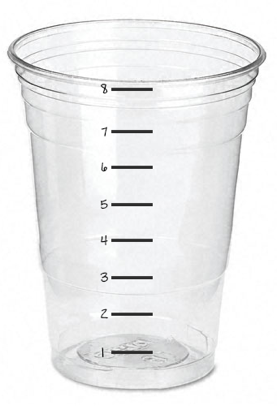
- Add water to the cup, filling it to the level 5 mark. Explain to the class that the water in the cup represents the supply of nutrients that a plant needs to grow. Remind students that plants need nutrients to be healthy just like people need nutrients in their diets. To help students understand and visualize the plant growth process, demonstrate/narrate the following:
- Seeds are planted in a field. After receiving moisture, they germinate and use the food energy stored in the seed to begin to grow.
- As the plants continue to grow, they need additional nutrients because the nutrients in the seed become depleted. (Instruct the student volunteer to drink the water until the level drops to the level 3 mark.)
- As the plants mature and begin to produce flowers, followed by fruits or seeds (such as corn, soybeans, vegetables, etc.), they need additional nutrients. (Instruct the student to drink two more units, leaving the water at the level 1 mark.)
- When the plants are harvested, the field rests until the next season. (The water level should remain at the level 1 mark.)
- The following season the field is planted again. Ask students, “Do we have more or less nutrients to begin season two with?” (less)
- The seeds germinate and begin to grow, once again requiring nutrients. (Drink the last unit of water.)
- As the plants continue to grow, more nutrients are needed. (Instruct student to drink one unit even though there is no water left). Remind the class that the plants are still hungry for nutrients so they keep trying to get them. As the volunteer student keeps sucking on the straw, explain that without proper nutrients the plants’ health will suffer: the plants will grow slow, they may turn yellow, they may be more susceptible to diseases and insects, and/or the size of the harvest they produce may decrease.
- Ask the students if there is a way the farmer can add nutrients to the soil. (Yes, they can add nutrients in a variety of ways, including mineral fertilizer, manure (from livestock), composted organic matter or by growing green crops (cover crops like alfalfa and clover).) Pour more water in the glass, representing the farmer applying nutrients to their field. Ask the student to drink another unit of water in order to have sufficient nutrients to finish the season and provide a harvest.
- Following the demonstration, project slides 3–4 of the slide deck and ask students the following questions:
- We know that crops need nutrients to grow, and farmers must replace soil nutrients. Could farmers add too many nutrients of any type (manure, fertilizer, compost) to their fields?
(Yes. If they add too much it costs them money, and there is a risk the nutrients will run off the land into bodies of water). - Could farmers also not add enough nutrients?
(Yes. If crops don’t receive enough nutrients they will be weaker, more susceptible to disease, produce less yield (which means less food), the crop will be less profitable and the soil won’t be as healthy.) - If growing plants deplete soil nutrients, why should farmers continue to grow crops?
(To produce our food so we can eat! Without farmers ensuring we have nutrient-rich soil we would not have a stable food supply.)
- We know that crops need nutrients to grow, and farmers must replace soil nutrients. Could farmers add too many nutrients of any type (manure, fertilizer, compost) to their fields?
- Remind students of the meaning of the word sustainability. Inform them that they will be learning how farmers can sustainably manage plant health to produce food for the world while also preserving the environment for future generations.
Explore and Explain
 Preparation: Prior to class, review the Background information, video clip and slide deck (including the speaker notes) associated with the lesson. Review the Teacher's Guide: Getting Started document for further information to prepare for class.
Preparation: Prior to class, review the Background information, video clip and slide deck (including the speaker notes) associated with the lesson. Review the Teacher's Guide: Getting Started document for further information to prepare for class.
Activity 1: Introduction to Soil Nutrients
- Slide 5: Play the Soil Nutrients video (5:04). Prepare students for the video by asking them to discover the answers to four questions: 1) What three primary nutrients are necessary for healthy plant growth, and how can they be replenished? 2) How does a plant resist disease and pests? 3) What are best management practices? and 4) What are the 4Rs? (Background and discussion prompts are outlined in the steps below and in the slide deck notes.)
- What three primary nutrients are necessary in the soil for healthy plant growth and how can they be replenished?
- Slide 6: Ask students, “Why does soil matter to agriculture and to us?” (Crops that we eat grow in the soil as well as the crops we use to feed livestock that provide us with foods like meat, milk and eggs.) Explain to students that just like we need nutrients, which we obtain from the food we eat, plants also require nutrients, which they get from the soil. Successful agriculture relies on healthy soil. The soil beneath our feet is one of our most precious resources; in reality, it makes life possible! It is much more than just dirt! Soil is composed of sand, silt, clay, plant nutrients, organic material, bacteria, crawling critters, oxygen, water and much more.
- Slide 7: Plants require 17 nutrients to grow. Ask students, “What three primary nutrients do plants need to grow?” (nitrogen (N), phosphorus (P), and potassium (K).)
- Remind students of the analogy used in the video of a bank and storing nutrients. As an additional example you can use a refrigerator analogy. Explain that we have to restock the refrigerator when we run out of food. Similarly, after we harvest a crop, we need to “restock” the soil with the nutrients that were used as the crop grew. This will allow the next crop to reach its full potential.
- Slide 8: Recap with students, “Where do soil nutrients come from?” (Nature! Fertilizer, manure, organic sources/compost.) Be sure your students recognize that soil nutrients come from both organic and inorganic sources. Organic nutrients come from sources that were once living. Examples include animal manure, green crops and composts. Inorganic nutrients come from natural mineral deposits in the earth, which can be mined and processed into fertilizers that are easy for farmers to use and for plants to absorb.
Three Dimensional Learning Proficiency: Disciplinary Core Ideas
Students are able to link key science concepts from the four domains of science: physical science; life science; earth and space science; with problem solving (engineering) and the application of science through technology.
Earth and Space Science: The sustainability of human societies and the biodiversity that supports them requires responsible management of natural resources.
- How does overall plant health affect a plant’s ability to resist disease and pests?
- Slide 10: Ask students to picture two individuals. One eats a balanced diet, exercises and has overall good health. The other does not consume a healthy diet and is much less healthy. If both of these individuals were exposed to the same contagious illness, which one is more likely to get sick? (The less-healthy individual.)
- Slide 11: Explain that plants can also exhibit varying levels of overall health. Optimal plant health begins with proper nutrients. For plants, most nutrients are absorbed through the soil. Many nutrients are essential in photosynthesis, the process plants use to make their food. Kind of like cooking a balanced, healthy meal requires ingredients from all the food groups, plants need a balanced variety of nutrients in the soil in order to be healthy. Ask, “What can make a plant sick or destroy a plant?” Allow students to offer answers, then provide the following:
- Insects
- Diseases
- Nutrient deficiencies
- Weed infestation
- Slide 12: As a class, discuss the benefits of maintaining optimal plant health.
- Plants will be better able to resist pests and disease, thereby requiring less human intervention.
- Plants will grow vigorously and be able to outcompete (grow faster than) weeds.
- Plants will grow to their genetic potential and produce more food.
- What are best management practices and the 4Rs?
- Slide 13: Point out to students that we make lots of choices in life; some choices are poor, others are good, and still others are better or best. The same is true in managing plant health. In agriculture the term best management practice refers to the best way to do something. Ask students if they can think of ways to protect the soil. Farmers use a variety of soil conservation practices to prevent erosion (contour plowing, terracing, windbreaks, cover crops, crop rotation, no-till farming, etc.) and other technologies to maximize yields sustainably. These are examples of best management practices.
- Slide 14: The 4R Nutrient Stewardship System represents the best known method of applying nutrients to crops. Regardless of the type of nutrient used, these practices must be followed for ideal crop yields, environmental protection and economic returns.
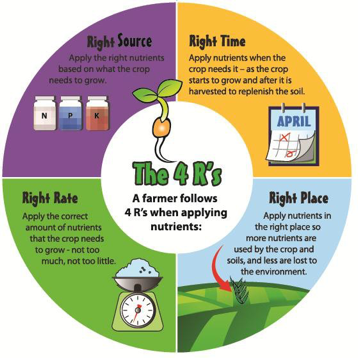
- Slide 15: Have students compare the canola test plot on the left to the plot on the right. Ask, "Which crop appears healthier?" Inform students that the plot on the right relied only on the existing soil nutrients for plant growth, which was not sufficient. The plot on the left was fertilized following the 4R Nutrient Stewardship model. As a result, the canola crop had the proper nutrients to grow to its best potential. Note the following points:
- When fertilizers are used properly, they provide the exact nutrients needed by soils and plants, reducing the risk of losses to the environment.
- Fertilizer applied based on science and the 4R Nutrient Stewardship guidelines is essential as we strive to feed the world.
- Manufactured fertilizers are responsible for 50% of the world's food supply. Without it, we couldn't feed everyone.
Three Dimensional Learning Proficiency: Crosscutting Concepts
Students link different domains of science fields into a coherent and scientifically-based view of the world.
Cause and Effect: Systems can be designed to cause a desired effect.
Activity 2: Sustainability Farm Game Level 2 Nutrients 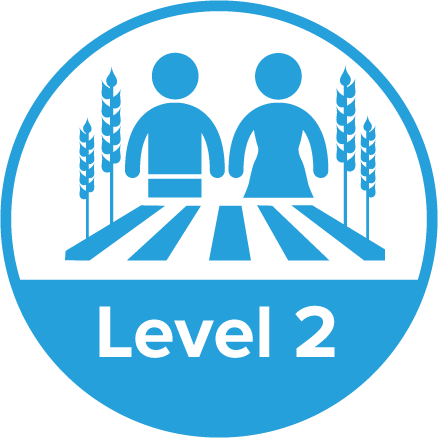
- Slides 16–18: Open Level 2 of the Sustainability Farm Game on each student’s computer or device. Explain that this level of the game allows them to farm in more countries (Kenya, India, and Canada or the United States). Prepare students for the game by informing them of the following:
- Level 2 allows you to see the impacts of adding nutrients to the soil. You will be comparing three nutrient management practices.
- As you farm, you will be asked if you want to make investments that will cost money but will be used to improve the roads, research new seed varieties, Explain that these are examples of real-life investment opportunities that exist in each country.
- OPTIONAL: Divide your class into three groups and assign each group a specific nutrient practice. Group 1 will choose “No Nutrients” each time they plant a new crop. Group 2 will choose “Standard Practice” each time they plant a crop. Group 3 will choose “Best Practice” each time they plant a crop. (These nutrient management methods represent a poor, good and best practice.) Instruct students to stop after they finish the first round in Kenya. Their screens should show their sustainability scores and the results of their sustainability barrels. Once the students have finished round one, compare the results of the three groups and their nutrient management practices. What were their sustainability scores? What were their limiting factors? After the class discussion, allow the students to complete the next two rounds using the nutrient management practice that they deem best. Once they finish farming in Canada they will be done with Level 2 Have them stop here.
- Slides 19–20: Once students have completed the game, use the following questions to help students synthesize what they have learned:
- Which nutrient practice was best?
- What negative impacts on crop yield, environment or economics did you see if you applied excess nutrients? What if you didn’t apply enough nutrients? (When excess nutrients are applied, the crop can’t use them all, and the nutrients can be lost to the environment, potentially damaging water quality and habitats. Using excess nutrients isn’t economical for the farmer. When insufficient nutrients are applied, the crop cannot reach its full potential, earning less for the farmer and producing less food to feed the world.)
- Can farmers use nutrients while still farming in a sustainable way? (Refer back to the demonstration at the beginning of the lesson to tie the concepts together for understanding. Farmers who use best management practices monitor the health of their soil and apply soil nutrients as they are needed by following the 4Rs.)
Elaborate
-
Use the free, downloadable PDF Feeding the World and Protecting the Environment from the Nutrients for Life Foundation to provide an overview of sustainability and the 4R Nutrient Stewardship System.
-
To review the concept of best management practices, use the Best Management Practices video (1:06)
Evaluate
Review and summarize the following key concepts (Slide 21):
- Agriculture provides our food supply. Growing our food requires the use of nutrients, which must be returned to the soil through proper application in order to continue growing healthy crops.
- Crops grown in soil without proper nutrients are less healthy, less resistant to insects and diseases, and produce a less abundant harvest than crops grown in nutrient-rich soil.
- When plant health is managed using best practices, farmers can be more successful in harvesting an abundant crop of healthy foods.
Sources
- https://en.wikipedia.org/wiki/Bushel
- https://wagrains.org/wheat/
- https://www.ers.usda.gov/webdocs/publications/41880/33132_ah697_002.pdf
- https://en.wikipedia.org/wiki/Acre
- http://www.scidev.net/sub-saharan-africa/agriculture/news/fertile-soil-increases-crop-yields.html
- https://www.topcropmanager.com/the-role-of-fertilizer-in-growing-the-worlds-food-10387/
Acknowledgements
The Journey 2050 program was originally developed by Nutrien in collaboration with Calgary Stampede, Alberta Canola Producers Commission, Nutrients for Life Foundation, and Agriculture in the Classroom Canada. Authors and contributors were drawn from each of these organizations under the direction of Lindsey Verhaeghe (Nutrien) and Robyn Kurbel (Calgary Stampede.) The lessons were updated and revised in 2017 and 2022 with contributions from the original J2050 Steering Committee, the National Center for Agricultural Literacy, and the National Agriculture in the Classroom Organization.
Recommended Companion Resources
- Agricultural Pests
- Agriculture and the Sustainable Development Goals
- Agronomy - Grow with It!
- Feeding the World and Protecting the Environment
- Insect Herbivores and Plants
- Is There Ever Too Much of a Good Thing?
- Journey 2050
- Journey 2050 Program Summary: Project-Based Learning
- Mobile System Removes Phosphorus From Manure
- Move 'N Around—The Nitrogen Cycle Game
- Nitrogen & Agriculture
- Phosphate Mining Video
- Potash Mining Video
- Soil Health Education Resources
- Soil Life
Author
Organization
| We welcome your feedback! If you have a question about this lesson or would like to report a broken link, please send us an email. If you have used this lesson and are willing to share your experience, we will provide you with a coupon code for 10% off your next purchase at AgClassroomStore. |
